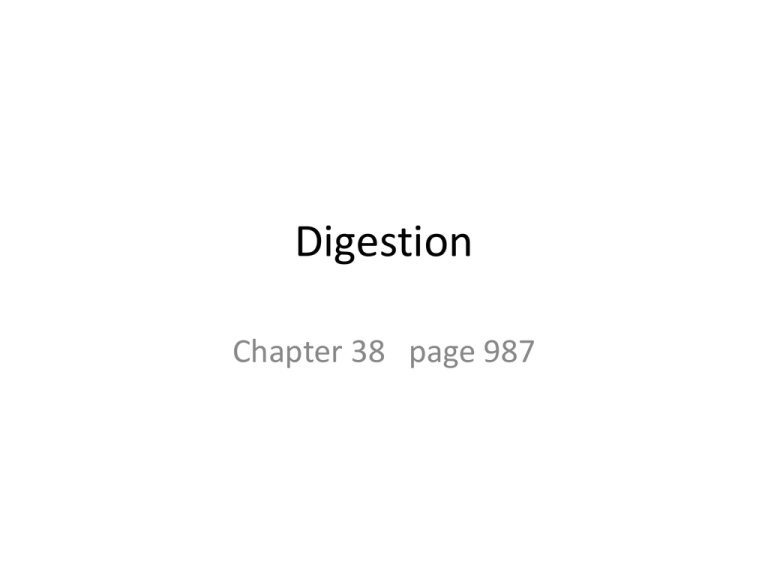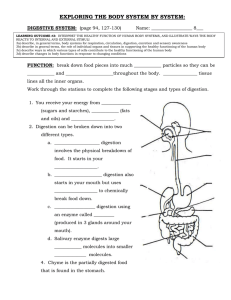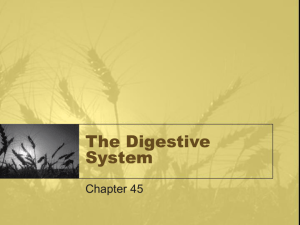digestion_1
advertisement

Digestion Chapter 38 page 987 • There are four parts to digestion: 1. Ingestion – taking in of nutrients 2. Digestion – breakdown of large organic molecules into smaller molecules called nutrients by: a. Mechanical digestion (physically tearing, grinding or churning large pieces into smaller pieces) b. Chemical digestion (separating large molecules into smaller molecules through chemical reactions.) • 3. Absorption – the transport of digested nutrients from the small intestine (SI) into the tissues of the body. • 4. Egestion – removal of material that the body cannot digest • Nutrients are simple molecules used by an organism for energy and for building materials. Water Carbohydrates Lipids (fats) Protein Minerals Vitamins Digestive Tract or Alimentary Canal • The human digestive tract consists of 5 major organs and is well over 8 meters long in an adult: – – – – – 1. mouth 2. pharynx 3. esophagus (also spelled oesophagus) 4. stomach 5. small intestine • duodenum • jejunum • ileum – 6. large intestine • rectum • anus The digestive tract includes the organs where the food actually goes, beginning at the mouth and ending at the anus. It is also called the alimentary canal. • The digestive system includes the organs of the digestive tract and organs that provide secretions to those organs. For example, food doesn’t go into the liver but the liver secretes a substance called bile into the pancreas which releases it into the small intestine when it is needed to help break down lipids. • Mechanical digestion, the breakdown of food begins in the mouth where it is chewed and broken apart into smaller pieces. • This gives more surface area for enzymes to attack and digest which speeds up chemical digestion. • Mechanical digestion of all foods begins in the mouth with mastication. • It continues in the stomach with the churning caused by the 3 layers of stomach muscles and with the secretin of hydrochloric acid. • Chemical digestion occurs when molecules are broken apart by enzymes. • Different enzymes chemically digest different nutrients and each enzyme works best in a certain temperature and pH level. • As we chew, 3 pairs of salivary glands secrete saliva into our mouths. Saliva lubricates the food and contains an enzyme, amylase, which starts the chemical digestion of COH. • Mucous comes from the cells lining the mouth, making it easier to swallow. • http://www.youtube.com/watch?v=IxNpXO8g GFM • Swallowing: Combined action of the throat and mouth muscles push the clump of chewed food, the bolus, into the esophagus. The epiglottis, a small flap of skin covering the opening of the trachea, prevents food from going the wrong way. • The contractions of the muscles in the esophagus, peristalsis, squeeze the food through the esophagus into the stomach. (see Figure 38-11, page 980) • A thick ring of muscle, the cardiac sphincter, closes the esophagus after the food enters the stomach and keeps the stomach acid from moving into the esophagus. • The stomach is a large sac lined with three layers of muscles. Glands in stomach lining produce mucous. Other glands produce hydrochloric acid. • Mechanical digestion in stomach- Muscles alternate to churn food and hydrochloric acid. • Chemical digestion- The acid activates an enzyme called pepsin which is secreted by a third set of glands. Pepsin starts the digestion of protein. Amylase is denatured. Amylase (or any enzymes for that matter) denatures when the temperature or pH level strays too far from the optimal level. For example, the amylase works in a slightly basic pH. When the pH rapidly drops as it moves down the esophagus and into the stomach, the enzyme denatures and is no longer able to break down carbohydrates. • Chyme is the mixture of food and stomach juices, churned by the muscles in the stomach. Chyme leaves the stomach through the pyloric sphincter.








